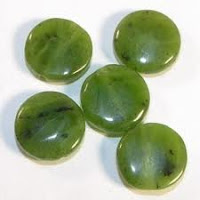Jade consists of two silicate minerals which are the Nephrite jade and Jadeitite. The origin of the word Jade came from "piedra de ijada", Spanish term for loin stone and is presumed useful in curing disease from kidneys and loins. However, nephrite came from Latin word "lapis nephriticus" meaning piedra de ijada. Although nephrite is softer that jadeite which is as hard as quartz, jadeite is less tough than nephrite and both can be shaped delicately. A French mineralogist on the 19th century found out that jade was really two different materials.
Jade Information
Jade Information
Earliest artifacts of this gemstone came from prehistoric times that were excavated were just uncomplicated ornaments with button, bead, some in tubular form, and was used for knives, axe heads and other weaponry. Jade's beauty as decorative objects and ornaments came more valuable when the metal-working technologies existed.
Durability
Nephrite measures between 5.5-6.0 Mohs hardness while Jadeite is in between 6.5-7.0 that's why it is possible to work with garnet sand or quartz and can also be refined with bamboo.
Colors
Jadeite has lots of color variations like pink, lavender-mauve, emerald green and sometime blue while Nephrite has fewer green color varieties but mostly found in a form of creamy white that is also known as "mutton fat" jade in China.
More on the Different Types of Jade
Jadeite is rare compared to nephrite because it can only be found in less than 12 places around the world. Most expensive variety even in the history and up to present is the translucent emerald-green jadeite. Jade is Wyoming, Alaska and British Columbia's official gemstone wherein it can be found at Cassiar regions and Lillooet in large deposits.
Aside from this gem to be a favorite material for calligraphy brushes, it is also crafted as mouthpieces of opium pipes because they believe that if they breathe through it, smokers benefit longevity. This stone also has a distinctive significance in the Chinese empire in the history of art fairly comparable to diamonds and gold in the West. This gem is used for furnishings of graves only for the imperial family high-ranking members.
Treatments
Stabilization or enhancement of jade can be categorized into three main methods and referred by some as ABC Treatment System.
The worth of jade is revealed by its color, its intensity, its texture and vivacity, its transparency and clarity. Fondness for specific colors differs from various regions and cultures as well. In the regions of Far East, highly esteemed jade are pure white and fine yellow having a delicate pink while in the USA and Europe, valuable one comes from apple green, spinach green, and emerald green.
Durability
Nephrite measures between 5.5-6.0 Mohs hardness while Jadeite is in between 6.5-7.0 that's why it is possible to work with garnet sand or quartz and can also be refined with bamboo.
Colors
Jadeite has lots of color variations like pink, lavender-mauve, emerald green and sometime blue while Nephrite has fewer green color varieties but mostly found in a form of creamy white that is also known as "mutton fat" jade in China.
More on the Different Types of Jade
Jadeite is rare compared to nephrite because it can only be found in less than 12 places around the world. Most expensive variety even in the history and up to present is the translucent emerald-green jadeite. Jade is Wyoming, Alaska and British Columbia's official gemstone wherein it can be found at Cassiar regions and Lillooet in large deposits.
Aside from this gem to be a favorite material for calligraphy brushes, it is also crafted as mouthpieces of opium pipes because they believe that if they breathe through it, smokers benefit longevity. This stone also has a distinctive significance in the Chinese empire in the history of art fairly comparable to diamonds and gold in the West. This gem is used for furnishings of graves only for the imperial family high-ranking members.
Treatments
Stabilization or enhancement of jade can be categorized into three main methods and referred by some as ABC Treatment System.
- The type A jadeite can only be treated by surface waxing.
- Type B's outcome has a significant enhancement with regards to its transparency as well as the color of the material. However, it needs to expose a stained piece to acids or chemical bleaches then impregnate it by a clear polymer resin. Presently, the best accurate test is the infrared spectroscopy in polymer detection of jadeite.
- Type C enhancement is by dyeing or by staining it artificially. Red jade got its red color with the enhancement of heat. To some extent, results are uncontrollable leading to a dull brown in color and usually its translucency is lost. B+C jade underwent the process of both impregnation and dyed artificially.
- Lastly, type D refers to complex stone like doublet consisting of a jade top with a backing made out of plastic.
The worth of jade is revealed by its color, its intensity, its texture and vivacity, its transparency and clarity. Fondness for specific colors differs from various regions and cultures as well. In the regions of Far East, highly esteemed jade are pure white and fine yellow having a delicate pink while in the USA and Europe, valuable one comes from apple green, spinach green, and emerald green.






No comments:
Post a Comment